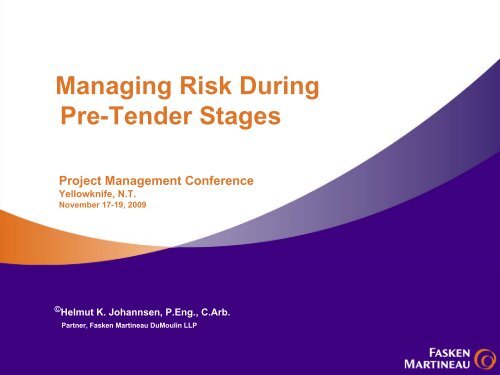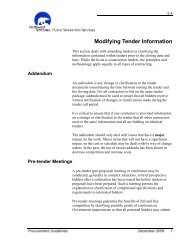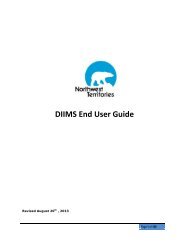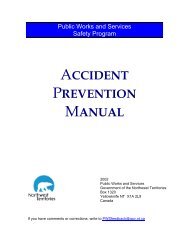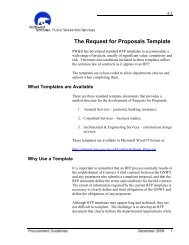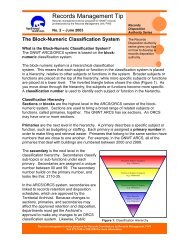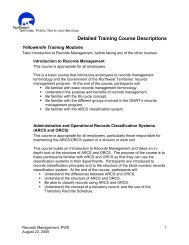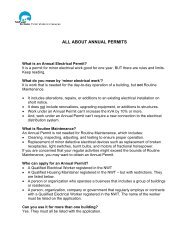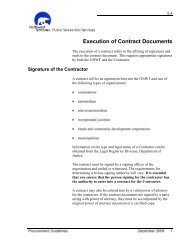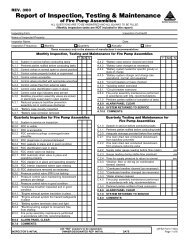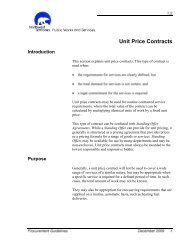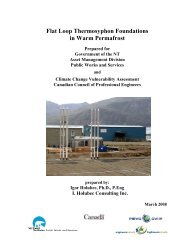Managing Risks - Department of Public Works and Services
Managing Risks - Department of Public Works and Services
Managing Risks - Department of Public Works and Services
Create successful ePaper yourself
Turn your PDF publications into a flip-book with our unique Google optimized e-Paper software.
<strong>Managing</strong> Risk During<br />
Pre-Tender Stages<br />
Project Management Conference<br />
Yellowknife, N.T.<br />
November 17-19, 2009<br />
© Helmut K. Johannsen, P.Eng., C.Arb.<br />
Partner, Fasken Martineau DuMoulin LLP
Introduction<br />
Some general principles <strong>of</strong> risk management<br />
General Comments on Project Development<br />
Process<br />
Procurement Strategies<br />
Procurement Process Issues<br />
<strong>Managing</strong> risks < closing time<br />
Some key contract risk issues<br />
<strong>Managing</strong> risks < award<br />
Project example<br />
Practice tip<br />
2
Some General Principles<br />
<strong>Managing</strong> pre-tender risks means identifying<br />
<strong>and</strong> addressing in advance:<br />
General project development risks (e.g. l<strong>and</strong>,<br />
finance <strong>and</strong> regulatory approval issues)<br />
Procurement process risks (e.g. non-compliant<br />
proposals/tenders)<br />
Contract performance risks (after contract award)<br />
No “one size fits all” approach<br />
In preparing procurement documents or in<br />
deciding whether to bid, must underst<strong>and</strong><br />
proposed risk allocation <strong>and</strong> contractual risk<br />
transfer after contract award<br />
3
Some General Principles (cont’d)<br />
Every project is different<br />
Size <strong>and</strong> complexity<br />
Mix <strong>of</strong> new construction/expansion/renovation<br />
Single project or staged construction/ turnover<br />
Schedule/budget pressures<br />
Number <strong>of</strong> construction/operation interfaces<br />
Financeability issues <strong>and</strong> constraints<br />
Effort required to identify <strong>and</strong> manage risks not<br />
always dependent on project size or value<br />
4
Some General Principles (cont’d)<br />
2007-2008 Market Conditions:<br />
Contractors, consultants <strong>and</strong> suppliers had<br />
surplus <strong>of</strong> work<br />
No time or willingness to review significant non-st<strong>and</strong>ard<br />
contract terms at time <strong>of</strong> tender<br />
No desire or need to tender on a project that appears<br />
aggressively or unfairly weighted in favour <strong>of</strong> owner<br />
2009 Market Conditions:<br />
Receiverships, projects “on hold”, shortage <strong>of</strong><br />
work<br />
But contractors, consultants <strong>and</strong> suppliers are<br />
now more knowledgeable than before about risks<br />
<strong>and</strong> thus risk averse<br />
5
Some General Principles (cont’d)<br />
Risk must be acceptable to lenders or<br />
financing may not be available<br />
Risk analyses/assessments by lenders will<br />
likely differ substantially from that <strong>of</strong><br />
government party/private sector party<br />
Parties may apply probabilistic approach to risks<br />
(especially for cumulative risks)<br />
Lenders may not use same probabilistic approach<br />
<strong>and</strong>/or may look to “worst case scenarios”<br />
Best strategy for financeability may not be<br />
best strategy for design <strong>and</strong> construction!<br />
6
Some General Principles (cont’d)<br />
<strong>Risks</strong> must be understood before they can be<br />
allocated<br />
Risk management is a formal process that<br />
enables identification, assessment, planning<br />
<strong>and</strong> management <strong>of</strong> risks<br />
Risk management is necessary in each<br />
phase <strong>of</strong> a project:<br />
Pre-tender phase<br />
Tender phase to contract award<br />
Post contract award/implementation phase<br />
Identify – mitigate – control risks<br />
7
Some General Principles (cont’d)<br />
Basic risk management strategy:<br />
Avoid risk – eliminate uncertainty<br />
Accept risk<br />
Transfer risk<br />
Mitigate risk<br />
Implement risk management strategy through<br />
Proper planning<br />
Clear, concise & consistent contract & specs<br />
Comprehensive, integrated insurance program<br />
Performance security: bonds (with riders?), bank<br />
guarantees, letters <strong>of</strong> credit, “good” parent<br />
company guarantees, etc.<br />
8
Some General Principles (cont’d)<br />
In theory, “risks should be borne by the party<br />
best able to h<strong>and</strong>le <strong>and</strong> manage the risk”<br />
Distinction between:<br />
“h<strong>and</strong>ling <strong>and</strong> managing” the risk; <strong>and</strong><br />
willingness or ability to bear consequences if <strong>and</strong><br />
when risk materializes<br />
This distinction <strong>of</strong>ten over-rides the general theory<br />
Optimum risk allocation is not maximum<br />
transfer <strong>of</strong> all risks<br />
Owners <strong>of</strong>ten fail to underst<strong>and</strong> <strong>and</strong> take into<br />
account that general contractors pass/push<br />
risks down<br />
9
Some General Principles (cont’d)<br />
Risk matrix is critical risk management tool<br />
Should a risk matrix be included in<br />
procurement documents/contracts?<br />
Often misleading in defining true risk allocation<br />
Beware <strong>of</strong> reliance on risk matrix as<br />
substitute for detailed risk review<br />
Contract language can contain subtle differences<br />
from risk allocation assumed from matrix<br />
Matrix may conflict with contractual terms or fail to<br />
fails to clearly identify retained risks (e.g. if<br />
contract liability caps exceeded)<br />
10
Some General Principles (cont’d)<br />
No “one size fits all” approach<br />
Risk allocation <strong>and</strong> contractual risk transfer<br />
depend on many things, including:<br />
Nature <strong>of</strong> contractual relationship<br />
Market conditions<br />
Each party’s ability <strong>and</strong> willingness to:<br />
accept a risk<br />
manage a risk<br />
insure against the risk<br />
A contract simply records final contractual risk<br />
allocation <strong>and</strong> transfer as agreed to by parties<br />
11
Some General Principles (cont’d)<br />
<strong>Risks</strong> <strong>of</strong>ten allocated to more than 1 person<br />
E.g. subsurface risk<br />
Owner allocates to contractor, who allocates to<br />
subcontractor<br />
But – contractor <strong>and</strong> subcontractor may have<br />
liability caps <strong>and</strong>/or exculpatory provisions that<br />
leave owner with some residual risk<br />
E.g. “insured risks”<br />
When risks transferred to insurers, there may be<br />
limits <strong>of</strong> liability, specific exclusions <strong>and</strong> gaps in<br />
coverage so residual risk remains to be borne by a<br />
party to the construction contract<br />
12
Project Development Process<br />
Often involves “Three Tracks”<br />
I: Environmental/Regulatory Process<br />
II: Industry Competition/Procurement Process<br />
III: Owner’s Other Commitments/Obligations<br />
Each track has its own risks, <strong>and</strong> these can<br />
impact other tracks as well, including through:<br />
Schedule<br />
Additional obligations/liabilities<br />
Project viability<br />
Alternative Development Strategies<br />
Run tracks sequentially<br />
Running tracks concurrently<br />
13
Project Development Process (cont’d)<br />
Example <strong>of</strong> Concurrent Tracks<br />
DESIGN -- EVALUATE -- BUILD<br />
TRACK I - Environmental / Regulatory<br />
<strong>Public</strong>, First Nations & other consultations<br />
Environmental approvals, regulatory licenses<br />
TRACK II - Industry D-B Competition<br />
Base Concept EOIs Proposal Competition<br />
Final Evaluation<br />
D-B Contract<br />
engin. & constr.<br />
shortlist<br />
technical & legal requirements<br />
feasibility & viability<br />
award & build<br />
TRACK III - Owner’s Commitment<br />
Planning, infrastructure works, power sales,<br />
facilitation agreements, modeling, financing<br />
DEVELOPMENT<br />
PHASE<br />
CONSTRUCTION<br />
PHASE<br />
14
Project Development Process (cont’d)<br />
Track I: Environmental/Regulatory<br />
Owner working with the public <strong>and</strong> government<br />
Objective: regulatory approvals necessary for<br />
project to proceed<br />
Track II: Industry Competition/Procurement<br />
Process<br />
Owner working with industry engineers, architects<br />
<strong>and</strong> contractors<br />
Objective: quality/cost optimized project & viable<br />
construction contract<br />
15
Project Development Process (cont’d)<br />
Track III: Owner’s Commitments<br />
Owner satisfying itself that all other requirements<br />
for project to proceed have been met <strong>and</strong><br />
obtained, including rights to l<strong>and</strong>s, temporary work<br />
spaces, other infrastructure that may be required<br />
(e.g. access, utilities, etc.), financing, internal<br />
board approvals, etc.<br />
Objective: project facilitating financial <strong>and</strong> physical<br />
resources, sales arrangements, <strong>and</strong> other legal<br />
agreements as necessary<br />
16
Project Development Process (cont’d)<br />
Environmental/Regulatory <strong>Risks</strong><br />
Early identification <strong>of</strong> required Permits, Licences<br />
<strong>and</strong> Approvals is essential<br />
Does the Project require Environmental<br />
Assessment? French Translations for CEAA?<br />
Scope <strong>of</strong> Assessment?<br />
How to deal with design-build & P3 processes?<br />
To mitigate risks must anticipate<br />
environmental issues during review process<br />
E.g. Project which had significant environmental<br />
issues re sturgeon<br />
Complex Computational Fluid Dynamics Model<br />
performed to assess flow patterns in spawning areas<br />
Inclusion <strong>of</strong> “sturgeon exclusion screens”.<br />
17
Project Development Process (cont’d)<br />
Procurement Process <strong>Risks</strong><br />
Request for Expressions <strong>of</strong> Interest (REOI)<br />
Pre-qualification Process (RFQ)<br />
Request for Proposals (RFP)<br />
Request for Tenders (RFT)<br />
Poor processes <strong>and</strong>/or poor risk allocation may be<br />
obstacles to finding pool <strong>of</strong> interested <strong>and</strong><br />
qualified bidders<br />
Consider doing market research before finalizing<br />
processes for major projects<br />
18
Project Development Process (cont’d)<br />
Owner’s Commitments/Obligations <strong>Risks</strong><br />
Property rights – Permanent <strong>and</strong> Temporary<br />
title, rights-<strong>of</strong>-way, easements, access, crane overswing<br />
agreements, etc.<br />
Other Agreements<br />
E.g. Tenant Leases, Licences to Occupy, Energy Sales<br />
Agreements, etc.<br />
Internal board approvals<br />
Other approvals<br />
Municipal Council, Government Ministry, Treasury<br />
Board, Risk Management Branch, etc.<br />
Project Labour Agreements<br />
19
Project Development Process (cont’d)<br />
Owner’s Commitments/Obligations <strong>Risks</strong><br />
(cont’d)<br />
Municipal/Regional District requirements<br />
Development Permit/Building Permit process<br />
Development Cost Charges<br />
Municipal/regional infrastructure improvement<br />
requirements as conditions <strong>of</strong> development<br />
20
Project Development Process (cont’d)<br />
To identify, manage <strong>and</strong> mitigate risks, all<br />
risks should be in a Project Risk Register<br />
Project Risk Register must be constantly<br />
reviewed <strong>and</strong> updated as time passes to<br />
reflect changes<br />
If risks not identified, difficult to manage them<br />
through the procurement documents<br />
21
Procurement Strategy<br />
Identify general procurement constraints<br />
Stakeholder requirements/constraints<br />
Regulatory/environmental permitting<br />
<strong>and</strong> approval processes <strong>and</strong> requirements<br />
First Nation issues<br />
Requirements for public invitation or private<br />
invitation<br />
<strong>Public</strong> owner or private owner<br />
Pre-qualification/short-listing<br />
Competitive tendering/proposals vs. sole source<br />
Contracting model <strong>and</strong> pricing model<br />
22
Procurement Strategy (cont’d)<br />
Select contract model that best reflects<br />
desired risk allocation through a walk down<br />
“Acronym Alley”:<br />
PO: Purchase Order<br />
D-B-B: Design-Bid-Build or “Traditional”<br />
D-B: Design-Build or Design-Construct<br />
EPC: Engineer-Procure-Construct<br />
EPCM: Engineer-Procure-Construct-Manage<br />
AC: Alliance Contract<br />
BOT: Build-Operate-Transfer<br />
BOOT: Build-Own-Operate-Transfer<br />
BLT: Build-Lease-Transfer<br />
FDBOM: Finance-Design-Build-Operate-Maintain<br />
PPP: <strong>Public</strong> Private Partnership (P3)<br />
23
Procurement Strategy (cont’d)<br />
Select pricing model that best reflects desired<br />
risk allocation:<br />
Stipulated Price/Lump Sum<br />
Unit Price<br />
Cost Plus<br />
Fixed Fee<br />
GMP<br />
Target Price<br />
Combination <strong>of</strong> above<br />
Note that pricing model/strategy largely<br />
independent <strong>of</strong> contracting model/strategy<br />
24
Risk Transfer<br />
Shifting the risk<br />
CONTRACT TYPE<br />
OWNER<br />
RISK<br />
CONTRACTOR<br />
Management Contracts<br />
Construction Management<br />
Traditional Unit Price<br />
Bill <strong>of</strong> Approximate Quantity<br />
Traditional Lump Sum<br />
Fixed Price / GMP<br />
Design <strong>and</strong> Build<br />
Complete “Package”<br />
Private Finance Initiative<br />
P3 or DBFO<br />
25
Design-Bid-Build or “Traditional”<br />
Method <strong>of</strong> project delivery in which an owner:<br />
contracts directly with a consultant to prepare the<br />
detailed design, drawings <strong>and</strong> specifications for<br />
the project; <strong>and</strong><br />
subsequently contracts directly with a contractor to<br />
construct the project to the owner’s design,<br />
drawings <strong>and</strong> specifications.<br />
The construction contract is typically (not<br />
always) administered by the owner’s<br />
consultant<br />
26
EPCM vs. Design-Bid-Build Approach<br />
Method <strong>of</strong> project delivery in which an owner<br />
contracts with another party (typically an<br />
engineer) to:<br />
provide design, drawings <strong>and</strong> specifications;<br />
procure equipment <strong>and</strong> construction by entering<br />
into contracts as agent for the owner with<br />
suppliers <strong>and</strong> contractors, or prepare contracts<br />
directly for owner’s signature; <strong>and</strong><br />
administer <strong>and</strong> manage the equipment <strong>and</strong><br />
construction contracts on behalf <strong>of</strong> the owner.<br />
27
Design–Bid–Build or “Traditional”<br />
OWNER’’S<br />
CONSULTANT<br />
PREPARE<br />
DESIGN<br />
OWNER<br />
ADMINISTER<br />
CONTRACT<br />
$<br />
CONSTRUCTION OF<br />
OWNER’S DESIGN<br />
CONTRACTOR<br />
Trade Contractor<br />
Supplier<br />
Trade Contractor<br />
D/B Contractor<br />
28
Summary <strong>of</strong> Design-Bid-Build<br />
Some Advantages<br />
Well understood<br />
Single design contract<br />
<strong>and</strong> single construction<br />
contract<br />
Often fixed price<br />
GC at risk for<br />
Price<br />
Schedule<br />
Quality<br />
OH&S<br />
Single bonds<br />
Predictable<br />
St<strong>and</strong>ard form contracts<br />
Some Disadvantages<br />
Difficult to fast track<br />
Quality <strong>and</strong> completeness <strong>of</strong><br />
documents critical<br />
Design<br />
Specifications<br />
Drawings<br />
Contract<br />
Change Orders expensive<br />
(delays <strong>and</strong> extras)<br />
Market dependent<br />
Ill-suited for renovations &<br />
expansions<br />
29
Construction Management (CM not “at risk”)<br />
OWNER’’S<br />
CONSULTANT<br />
PREPARE<br />
DESIGN<br />
OWNER<br />
$<br />
CONSTRUCTION OF<br />
OWNER’S DESIGN<br />
CONSTRUCTION<br />
MANAGER<br />
Trade Contractor<br />
Supplier<br />
Trade Contractor<br />
D/B Contractor<br />
30
Construction Management (CM not “at risk”)<br />
Some Advantages<br />
Fast track friendly with<br />
“just in time” design<br />
Flexible start <strong>and</strong> stop<br />
Experienced CM assists<br />
management <strong>of</strong> design/<br />
construction interfaces<br />
High Owner/Consultant<br />
dem<strong>and</strong>s<br />
Owner can weigh<br />
trade/supplier pricing<br />
against risk transfer<br />
Some Disadvantages<br />
Multiple<br />
contracts/Interfaces/bonds<br />
Cost, schedule, quality, OH&S<br />
at Owner’s risk<br />
Performance risk with Owner<br />
Difficult to control cost<br />
Requires experienced owner<br />
knowledgeable <strong>of</strong> risks<br />
Lack <strong>of</strong> project definition prior<br />
to contract award<br />
Patchwork quilt <strong>of</strong> bonds<br />
31
Construction Management (CM “at risk”)<br />
OWNER’’S<br />
CONSULTANT<br />
PREPARE<br />
DESIGN<br />
OWNER<br />
$<br />
CONSTRUCTION OF<br />
OWNER’S DESIGN<br />
CONSTRUCTION<br />
MANAGER<br />
$<br />
TRANSITION FROM CONSTRUCTION MANAGER<br />
TO GENERAL CONTRACTOR<br />
CONTRACTOR<br />
Trade Contractor<br />
Supplier<br />
Trade Contractor<br />
D/B Contractor<br />
32
Construction Management (CM “at risk”)<br />
Some Advantages<br />
“One Contract”<br />
Fast track friendly with<br />
“just in time” design<br />
Flexible start <strong>and</strong> stop<br />
Experienced CM assists<br />
management <strong>of</strong> design/<br />
construction interfaces<br />
Owner can weigh<br />
trade/supplier pricing<br />
against risk transfer<br />
OH&S at CM’s risk<br />
Some Disadvantages<br />
Risk <strong>of</strong> changes<br />
Late design<br />
Cost, schedule, quality at<br />
Owner’s risk<br />
Performance risk can still be<br />
with Owner<br />
Difficult to control cost<br />
Requires experienced owner<br />
knowledgeable <strong>of</strong> risks<br />
Lack <strong>of</strong> project definition prior<br />
to contract award<br />
Patchwork quilt <strong>of</strong> bonds<br />
33
Construction Management - General<br />
Regardless <strong>of</strong> “at risk” or “not at risk”, must<br />
clarify <strong>and</strong> then control:<br />
Contract Team (bait <strong>and</strong> switch, departures)<br />
Contract Fee<br />
Disbursements (internal, from affiliates, markups)<br />
Own Forces work<br />
Sharing risk <strong>of</strong> savings <strong>and</strong> over-runs<br />
Construction Management:<br />
Theoretically superior - but theory not always reality<br />
Often becomes “cost plus” in reality regardless <strong>of</strong><br />
pricing structure<br />
34
Design-Build / Design & Construct<br />
Owner contracts with design-build contractor<br />
to design <strong>and</strong> construct a project<br />
Design-build contractor is responsible for<br />
design, procurement <strong>and</strong> construction<br />
Owner or owner’s consultant administers the<br />
design-build contract<br />
Variations<br />
Owner’s requirements can be prepared by owner,<br />
owner’s consultant or design-build contractor<br />
May be for entire project or only for specific parts<br />
<strong>of</strong> a project (e.g. “water to wire”, turbine genset for<br />
cogeneration or wind power, recovery boiler for a<br />
pulp mill, etc.)<br />
35
Engineer-Procure-Construct (EPC)<br />
Method <strong>of</strong> project delivery in which an owner<br />
contracts with another party (EPC contractor)<br />
to:<br />
engineer;<br />
procure; <strong>and</strong><br />
construct<br />
project to meet owner’s statement <strong>of</strong> requirements.<br />
Some publications use Engineer-Procure-<br />
Construct-Install (“EPCI”)<br />
Most publications/authors define EPC as<br />
“similar to Design-Build”<br />
36
Turnkey<br />
The “turnkey” arrangement, (also known as the “package<br />
deal”, “design <strong>and</strong> build”, “clé-en-main” or “design <strong>and</strong><br />
construct”) places the duty to design <strong>and</strong> construct solely<br />
on the contractor. There is no accepted definition for<br />
each <strong>of</strong> these terms in the construction field. The term<br />
“turnkey” tends to mean the most extreme form <strong>of</strong> placing<br />
design <strong>and</strong> construction responsibility on the contractor,<br />
such that after completion the employer need only turn the<br />
key to commence operation <strong>of</strong> the constructed facility.<br />
Notwithst<strong>and</strong>ing this, the term “turnkey” will be used here<br />
to describe the more general global arrangement <strong>of</strong><br />
placing both design <strong>and</strong> construction responsibilities on<br />
one contractor” (emphasis added)<br />
From Text “Underst<strong>and</strong>ing <strong>and</strong> Negotiating Turnkey Contracts”, by<br />
Joseph A. Huse (Freshfields), Sweet & Maxwell 1997<br />
37
Build-Operate-Transfer<br />
Method <strong>of</strong> project delivery in which a private<br />
company is given a concession to finance,<br />
design, build <strong>and</strong> operate a facility<br />
(powerplant, airport, toll road, etc.) normally<br />
built <strong>and</strong> operated by the government. At the<br />
end <strong>of</strong> the concession period, ownership<br />
<strong>and</strong>/or operation <strong>of</strong> the facility is transferred<br />
to the government. Variants include BOO (no<br />
transfer back), BOOT, DBFO, FDBOM, etc.<br />
38
P3/ D-B / EPC / Turnkey Common Themes<br />
Performance obligations<br />
Quality <strong>of</strong> overall product, performance <strong>of</strong> plant,<br />
modules <strong>and</strong> equipment<br />
Output - in terms <strong>of</strong> overall production/output<br />
Schedule completion<br />
Financing entities (banks, bond investors,<br />
etc.) <strong>of</strong>ten insist on underlying D-B contract<br />
for P3 <strong>and</strong> IPP projects<br />
Significant exposure <strong>of</strong> D-B contractor to<br />
damages<br />
Many risks normally borne by owner assigned<br />
to D-B contractor<br />
39
Design–Build Relationship (Theory)<br />
OWNER’S<br />
CONSULTANT<br />
ADMINISTER<br />
CONTRACT(?)<br />
PERFORMANCE<br />
SPECIFICATIONS<br />
$<br />
OWNER<br />
DESIGN-BUILD<br />
CONTRACTOR<br />
DESIGN TO PERFORMANCE SPECIFICATIONS,<br />
PROCURE AND CONSTRUCT<br />
LABOUR<br />
SPECIALTY<br />
SUBCONTRACTORS<br />
MATERIALS<br />
AND SUPPLIES<br />
Note: Design-Build Contractor assumed to be a single integrated firm<br />
40
Design–Build Relationship (Typical)<br />
OWNER’S<br />
CONSULTANT<br />
ADMINISTER<br />
CONTRACT(?)<br />
PERFORMANCE<br />
SPECIFICATIONS<br />
$<br />
OWNER<br />
DESIGN-BUILD<br />
CONTRACTOR<br />
DESIGN TO PERFORMANCE SPECIFICATIONS,<br />
PROCURE AND CONSTRUCT<br />
DESIGN<br />
CONSULTANTS<br />
SUBCONTRACTORS<br />
EQUIPMENT<br />
SUPPLIERS<br />
Note:<br />
Design-Build Contractor is typically a joint venture,<br />
consortium, special-purpose vehicle, etc.<br />
41
Some Advantages <strong>of</strong> Design-Build<br />
Single point responsibility<br />
Opportunity for innovation <strong>and</strong> faster project delivery<br />
Efficiency (design & construction expertise together)<br />
Fitness for purpose<br />
No real alternative for proprietary technology<br />
Fewer changes <strong>and</strong> implementation simplified<br />
Reduction <strong>of</strong> claims (or number <strong>of</strong> claims)<br />
Increased flexibility to address changed conditions<br />
Reduced administrative burden for owner<br />
Cost savings <strong>and</strong> more certainty <strong>of</strong> final price<br />
Improved risk management for owner<br />
Greater ability to evaluate contractors on factors<br />
other than cost<br />
42
Some Disadvantages <strong>of</strong> Design-Build<br />
Loss <strong>of</strong> control <strong>and</strong> reduced owner involvement in<br />
design<br />
Cost <strong>of</strong> tendering (to all parties)<br />
Difficulty/time comparing different designs<br />
Cost <strong>of</strong> risks <strong>and</strong> contingencies<br />
Danger <strong>of</strong> Design-Build becoming Build-Design<br />
Environmental/regulatory processes<br />
Limited pool <strong>of</strong> qualified Design-Builders<br />
QA/QC largely in contractor’s h<strong>and</strong>s<br />
Disputes tend to be larger <strong>and</strong> more complex<br />
Management <strong>of</strong> long term risks<br />
Some lack <strong>of</strong> project definition prior to contract award<br />
43
Some Owner Considerations D-B-B/D-B<br />
Design-Bid-Build<br />
Multiple projects to spread<br />
risks<br />
High risk tolerance<br />
High return on investment<br />
Internal resources <strong>and</strong><br />
expertise<br />
Complex environmental/<br />
regulatory permitting<br />
Owner can select “best”<br />
engineer & contractor<br />
independently<br />
Design-Build<br />
Single-point responsibility<br />
“One-<strong>of</strong>f” project<br />
Low risk tolerance<br />
Marginal project<br />
No internal resources<br />
Owner has limited<br />
expertise<br />
Need for proprietary<br />
technology<br />
Need for overall<br />
Performance Guarantees<br />
44
Some Contractor Considerations D-B-B/D-B<br />
Design-Bid-Build<br />
Civil contractor with no<br />
design-build expertise<br />
No design-build track record<br />
No historical relationships<br />
with engineers & suppliers<br />
Low risk tolerance<br />
Limited resources for<br />
pursuit costs<br />
Design-Build<br />
Specialty supplier/<br />
contractor<br />
Integrated design-build<br />
contractor<br />
Design-build track record<br />
Proprietary designs/<br />
technologies<br />
Substantial resources for<br />
pursuit costs<br />
Better control <strong>of</strong> destiny if<br />
it controls architect/<br />
engineer<br />
45
P3 Relationship<br />
(Typical for Infrastructure)<br />
GOVERNMENT<br />
PUBLIC<br />
ENTITY<br />
(“”OWNER”)<br />
BOND HOLDERS<br />
SENIOR<br />
DEBT<br />
EQUITY<br />
EQUITY<br />
$ FUNDING<br />
DIVIDENDS<br />
P3 CONTRACTOR<br />
(Private Partner SPV)<br />
$ FUNDING<br />
INTEREST &<br />
PRINCIPAL<br />
BANKS/BONDS/INVESTORS<br />
$<br />
DESIGN BUILD<br />
CONTRACTOR<br />
O & M SERVICE<br />
PROVIDER<br />
DESIGN<br />
CONSULTANTS<br />
SUBCONTRACTORS<br />
EQUIPMENT<br />
SUPPLIERS<br />
Note:<br />
P3 Contractor is typically special-purpose vehicle (to be formed)<br />
46
<strong>Public</strong>-Private-Partnerships (cont’d)<br />
No universal definition <strong>of</strong> P3<br />
P3s cover a wide range <strong>of</strong> projects,<br />
depending on asset ownership, risk sharing,<br />
financing <strong>and</strong> operation<br />
CCPPP includes as P3 examples: Design-<br />
Build; O&M Contract; Design-Build-Finance-<br />
Operate; Operation Licence (e.g. IT projects);<br />
Finance Only (e.g. bond issue for project)<br />
Current economic climate creates challenges<br />
for some P3 projects that involve large risk<br />
transfer <strong>and</strong> significant financing<br />
requirements.<br />
47
Summary <strong>of</strong> Contracting Models<br />
No universally accepted industry definitions<br />
for D-B-B, D-B, Design-Construct, EPC,<br />
EPCM, Turnkey, P3, etc. in terms <strong>of</strong> specific<br />
scope <strong>of</strong> work or risk allocation<br />
Use <strong>and</strong> Abuse <strong>of</strong> St<strong>and</strong>ard Forms<br />
“Adapting” st<strong>and</strong>ard form contracts to applications<br />
other than those for which they were intended<br />
Key Points:<br />
It is contractual risk allocation, not title <strong>of</strong> contract,<br />
that is determinative <strong>and</strong> must be reviewed with<br />
care<br />
In practice, terms <strong>of</strong>ten used loosely so it is always<br />
prudent to clarify terminology before<br />
misunderst<strong>and</strong>ings arise<br />
48
Procurement Process Issues<br />
Disputes over validity <strong>and</strong> enforceability <strong>of</strong><br />
tenders is a thriving business for lawyers<br />
Knowledge <strong>of</strong> current tendering law is critical<br />
RFPs vs. RFQs vs. Request for Bid<br />
Failure to properly address tendering law<br />
issues in the invitation to tender <strong>and</strong><br />
instructions to tenderers can:<br />
Expose owner/tendering authority to liability<br />
Expose consultant who prepared tender<br />
documents to liability<br />
Disrupt <strong>and</strong> delay entire project<br />
Feed the families <strong>of</strong> many lawyers<br />
49
Procurement Process Issues (cont’d)<br />
Threshold Issue: Use Request for Tenders or RFP?<br />
Want m<strong>and</strong>atory use <strong>of</strong> same contract/performance<br />
requirements?<br />
Allow departures from contract requirements?<br />
In tender/proposal?<br />
In negotiations following identification <strong>of</strong> highest-ranked<br />
submission?<br />
Want submissions to be fixed price & irrevocable?<br />
Want “bid security”? If so, what kind, for what purpose <strong>and</strong><br />
how will it be enforced?<br />
Will there be Fairness Monitor/Process Monitor?<br />
Willing <strong>and</strong> able to entertain bilateral meetings <strong>and</strong><br />
change commercial terms prior to closing?<br />
50
Procurement Process Issues (cont’d)<br />
Request for Tenders<br />
Tendering process to which tendering law applies<br />
Contract “A” <strong>and</strong> Contract “B”<br />
Contract “A” imposes obligations on Owner<br />
Limits<br />
Flexibility<br />
Discretion<br />
Negotiations<br />
51
Procurement Process Issues (cont’d)<br />
Request for Proposals<br />
Solicitation <strong>of</strong> interest (“invitation to treat”)<br />
Very flexible<br />
Limited obligations created (other than those<br />
under the terms <strong>of</strong> the RFP)<br />
Generally leads to negotiations<br />
Negotiation risk high after selection <strong>of</strong> preferred<br />
proponent<br />
52
Procurement Process Issues (cont’d)<br />
Use <strong>of</strong> term “RFP” or “Request for Tenders”<br />
is not conclusive <strong>and</strong> courts consider:<br />
Are terms “tender”, “bid”, “bidder” etc. used<br />
anywhere in documents, correspondence, etc.?<br />
Are proposals required to be “Irrevocable”<br />
Are proposals required to give fixed price?<br />
Are proposals required to conform to contract <strong>and</strong><br />
specifications issued by owner without exception?<br />
Do tender documents refer to “award” <strong>of</strong> contract?<br />
53
Procurement Process Issues (cont’d)<br />
What are ramifications on process <strong>of</strong>:<br />
“Short-listing” entities that do not exist until<br />
contract awarded?<br />
Changes in composition <strong>of</strong> proponent teams?<br />
Changes in internal contractual structure from that<br />
on which proponent was short-listed?<br />
Are you evaluating the entities named, or<br />
really their parent companies through<br />
consolidated financial information?<br />
Should procurement process allow designbuild<br />
teams flexibility to change<br />
members/arrangements?<br />
54
Procurement Process Issues (cont’d)<br />
Bid bonds & consent <strong>of</strong> surety<br />
Questionable security or value in other than<br />
traditional tendering situation<br />
Perhaps useful for use as pre-qualification tool<br />
Competition/Participation Agreements:<br />
Contractual commitment by proponent to submit<br />
conforming proposal, backed by appropriate<br />
proposal security (e.g. L/C)<br />
Contractual commitment by owner to pay<br />
honorarium (if applicable)<br />
Addresses owner entitlement to use ideas/designs<br />
<strong>of</strong> unsuccessful proponents<br />
55
Procurement Process Issues (cont’d)<br />
Regardless <strong>of</strong> RFP or Request for Tenders,<br />
minimize amendments to process/tender<br />
documents<br />
If substantial deficiencies/conflicts in design <strong>and</strong><br />
specs become evident, consider canceling tender<br />
call<br />
Beware <strong>of</strong> using question/answer series or RFI<br />
responses to avoid amending documents<br />
Dangerous to bind them into contract!<br />
56
Procurement Process Issues (cont’d)<br />
Alternates <strong>and</strong> Alternative Proposals<br />
Consider whether alternates permitted<br />
Evaluating alternates within base proposal<br />
Evaluating alternative proposals<br />
Defining winning criteria - Base Proposal or<br />
Alternate Proposal<br />
Opportunity for others to match alternates<br />
Negotiation<br />
Governed/limited by RFP/Request for Tenders<br />
Bid shopping vs. negotiation<br />
Sequential vs concurrent negotiations<br />
57
Procurement Process Issues (cont’d)<br />
Health Care Developers Inc. v. Newfoundl<strong>and</strong><br />
(1995) N.J. No. 48 (S.C.T.D.<br />
RFP to developers for design-build-lease <strong>of</strong> clinics<br />
“Invitation to Tender” advertisement & RFP<br />
documents used mixed language<br />
Held: Tender Call, particularly because ad<br />
required <strong>of</strong>fers be irrevocable<br />
58
Procurement Process Issues (cont’d)<br />
Khoury Real Estate <strong>Services</strong> Ltd. v. Canada<br />
(Minister <strong>of</strong> <strong>Public</strong> <strong>Works</strong>) (1996) 33 C.L.R.(2d) 294<br />
(Fed.T.D.).<br />
RFP to provide modern <strong>of</strong>fice space in Fredericton for<br />
Federal Government<br />
No overall st<strong>and</strong>ard <strong>of</strong> evaluation in RFP<br />
Khoury applied for basis <strong>of</strong> scoring <strong>of</strong> its proposal<br />
Held: Tendering rules apply. Owner must demonstrate it<br />
acted fairly <strong>and</strong> disclose evaluation/scoring <strong>of</strong> proposal<br />
59
Procurement Process Issues (cont’d)<br />
Cable Assembly Systems Ltd. V. Dufferin-Peel<br />
Roman Catholic Separate School Board (2000) O.J. No.<br />
577 (Ont. SC)<br />
RFP issued for cable plant & ethernet hubs in 88 elementary<br />
schools & contemplated negotiation<br />
Board met with 3 lowest proponents <strong>and</strong> then awarded to<br />
other than Cable<br />
Held: Board had duty to be fair to all “bidders” <strong>and</strong> to act in<br />
good faith<br />
Held: Cable was treated fairly as RFP did not limit<br />
negotiations to preferred proposal<br />
60
Summary - Procurement Process Issues<br />
Tendering Law can extend to RFP<br />
Court looks to substance not “style”<br />
Duty <strong>of</strong> fairness may apply<br />
Law applicable to tenders may or may not<br />
apply depending on terms <strong>of</strong> RFP<br />
Practice Tip: Draft RFP as true RFP but<br />
then treat it as if it will be held to be a<br />
Request for Tenders<br />
61
<strong>Managing</strong> <strong>Risks</strong> < Bid Closing<br />
Leading edge/bleeding edge<br />
New technology? Pushing the envelope?<br />
New application? European vs. N.A. practices?<br />
History <strong>of</strong> comparable work? Bridges vs. schools?<br />
Contract value > 150% <strong>of</strong> previous largest contract<br />
No substitution for knowledge <strong>and</strong><br />
experience<br />
Of consultants<br />
Of contractors/subcontractors/suppliers<br />
Of lawyers <strong>and</strong> other advisors<br />
People experience vs. corporate experience<br />
62
<strong>Managing</strong> <strong>Risks</strong> < Bid Closing (cont’d)<br />
Schedule – Political or Real?<br />
Allow sufficient time for preparation <strong>of</strong> bids<br />
Allow sufficient time for performance <strong>of</strong> work<br />
Consider environmental, noise & other restrictions<br />
Set contract completion date in advance <strong>of</strong><br />
required completion date<br />
Especially where occupancy/revenue generation is<br />
critical<br />
Provide some flexibility in subsequent contracts<br />
that are dependent upon completion<br />
E.g. leases, purchase contracts, production commitments<br />
3 years to plan <strong>and</strong> design but only 30 days to<br />
tender <strong>and</strong> then 3 months to construct!<br />
63
<strong>Managing</strong> <strong>Risks</strong> < Bid Closing (cont’d)<br />
Manage risks by appropriate pricing:<br />
Use a mixture <strong>of</strong> lump sums, unit prices, cash<br />
allowances, etc.<br />
Obtain fixed price for part <strong>of</strong> the scope <strong>of</strong> work,<br />
with cash allowance for other parts that are<br />
incomplete or may require large contingencies<br />
Bid Form/Price Breakdowns<br />
Allow for unbalanced bids?<br />
Influence on evaluation if broken down poorly?<br />
Quantity variations?<br />
Manage risks by “Early contractor<br />
involvement”?<br />
64
<strong>Managing</strong> <strong>Risks</strong> < Bid Closing (cont’d)<br />
Specifications/Drawings/Construction<br />
Avoid incomplete drawings <strong>and</strong> specifications<br />
Coordinate to ensure free <strong>of</strong> internal conflicts<br />
Recurring problem: 6” pipe in 4” wall syndrome<br />
Ensure consistency <strong>of</strong> terms <strong>and</strong> terminology<br />
Someone must be responsible for coordination<br />
Too little time <strong>and</strong> <strong>of</strong>ten too little money increases<br />
risks:<br />
Use <strong>of</strong> inappropriate precedents<br />
Too much cut <strong>and</strong> paste without conforming end product<br />
Avoid reliance on “Design Intent” to cover errors &<br />
omissions in drawings <strong>and</strong> specifications<br />
65
<strong>Managing</strong> <strong>Risks</strong> < Bid Closing (cont’d)<br />
Subsurface Conditions<br />
No such thing as too much geotechnical<br />
investigation prior to tendering<br />
Consider joint geotechnical program during<br />
tendering to manage the risk <strong>and</strong> reduce<br />
contingencies regardless <strong>of</strong> who bears the risk<br />
Consider risk sharing specific items<br />
E.g. where slope stability or potential presence <strong>of</strong> rock is<br />
an issue, perhaps:<br />
Contractor bears first portion <strong>of</strong> additional costs<br />
Owner <strong>and</strong> Contractor share next level <strong>of</strong> costs<br />
Owner (or Contractor) bears remainder<br />
66
<strong>Managing</strong> <strong>Risks</strong> < Bid Closing (cont’d)<br />
Subsurface Conditions (cont’d)<br />
Opportunity <strong>and</strong> time for investigation<br />
Risk allocation/management<br />
Baseline geotechnical report?<br />
Field investigations funded by owner during proposal<br />
competition?<br />
Issues re disclosure <strong>of</strong> field investigations by other<br />
proponents to owner/successful bidder<br />
Failure to disclose information can change initial<br />
assumed risk allocation<br />
67
<strong>Managing</strong> <strong>Risks</strong> < Bid Closing (cont’d)<br />
Labour<br />
Assess open shop/union shop issues<br />
Addressing <strong>and</strong> managing labour issues is critical,<br />
especially for out <strong>of</strong> province contractors<br />
Availability <strong>of</strong> skilled labour<br />
Keeping the labour force when competition arises from<br />
other projects <strong>of</strong>fering overtime/longer hours<br />
If longer work week/overtime required to keep existing<br />
force or attract more labour, who pays?<br />
If not available, is this force majeure?<br />
68
<strong>Managing</strong> <strong>Risks</strong> < Bid Closing (cont’d)<br />
Change Order Process<br />
Contracts must have workable processes for<br />
changes<br />
Colautti Construction v. City <strong>of</strong> Ottawa (1984),<br />
46 O.R. 2d 46 (Ont. C.A.) (emphasis added):<br />
“There is no doubt that this contract, drawn as it was to protect<br />
taxpayers, attempted to limit the liability <strong>of</strong> the City to such an<br />
extent that one would expect that not even the ordered rotation <strong>of</strong><br />
the seasons could be reasonably anticipated by the Contractor.<br />
The problem with contracts such as these is that they are so<br />
rigid <strong>and</strong> so restricting that the parties tend to amend them by<br />
their actions during the course <strong>of</strong> the contract. That was the<br />
situation in this case. There were several significant changes <strong>and</strong><br />
additions as to the work ordered by the City during the contract.<br />
None <strong>of</strong> these were in writing. All but the items in dispute in this<br />
case were paid for by the City.”<br />
69
<strong>Managing</strong> <strong>Risks</strong> < Bid Closing (cont’d)<br />
Owner <strong>and</strong> Contractor must both consider<br />
some additional key contractual risk issues,<br />
including:<br />
Performance Guarantees<br />
Performance Specifications<br />
Liquidated Damages<br />
Consequential Damages<br />
70
Performance Guarantees<br />
Heart <strong>of</strong> the contract but <strong>of</strong>ten poorly drafted<br />
Especially true in industrial contracts<br />
Close collaboration required between lawyers<br />
<strong>and</strong> consultants<br />
Rarely can consultants or lawyers working alone<br />
draft clear <strong>and</strong> enforceable performance<br />
guarantees<br />
Enforceability dependent on quality <strong>and</strong><br />
completeness <strong>of</strong> drafting<br />
71
Performance Guarantees (cont’d)<br />
Focus on inputs <strong>and</strong> outputs<br />
If inputs not to spec, are outputs guaranteed?<br />
Two levels <strong>of</strong> Performance Guarantees<br />
Performance <strong>of</strong> Facility as a whole<br />
Performance <strong>of</strong> individual components,<br />
equipment, subsystems <strong>and</strong> systems<br />
Keep the distinction clear throughout the<br />
documents!<br />
72
Performance Guarantees (cont’d)<br />
Key questions for performance guarantees<br />
What is guaranteed<br />
Performance tests<br />
Who develops them <strong>and</strong> when?<br />
When are tests performed?<br />
Who performs tests?<br />
How are measurements taken? Frequency? Number?<br />
Use average <strong>of</strong> all or discard highest <strong>and</strong> lowest?<br />
Consequences if tests stopped or fail?<br />
Due to shortages/problems attributed to owner<br />
Due to deficiencies/problems in equipment<br />
73
Performance Specifications<br />
Often not well drafted<br />
Often fail to address “Big Picture”<br />
Establish logical structure <strong>and</strong> simplified<br />
section referencing<br />
For each component part <strong>of</strong> project, identify<br />
overall performance requirement separately from<br />
detailed requirements<br />
Use consistent numbering format throughout!<br />
Only specify details where critical to Owner<br />
Detailed specifications can undermine<br />
performance specifications <strong>and</strong> enforceability <strong>of</strong><br />
performance guarantees<br />
74
Performance Specifications (cont’d)<br />
Use <strong>of</strong> general reference “st<strong>and</strong>ards”<br />
“St<strong>and</strong>ard Industry Practice”, “Prudent Utility<br />
Practice” <strong>and</strong> other “Motherhood Provisions”.<br />
<strong>Public</strong> Utility vs. IPP<br />
“Current Practice”<br />
Define what you mean<br />
References to Codes <strong>and</strong> St<strong>and</strong>ards<br />
Some codes contain discretionary items or require<br />
contract to specify certain requirements.<br />
Application <strong>of</strong> Code where items not specified.<br />
Additional load factors or capacity reductions for<br />
codes <strong>and</strong> st<strong>and</strong>ards<br />
75
Liquidated Damages<br />
Liquidated Damages vs. Penalties<br />
Two edged-sword – represent the maximum<br />
amount recoverable if the event to which they<br />
are tied occurs<br />
Sample Contract Definition:<br />
“Liquidated Damages” are not a penalty but represent the<br />
amount(s) agreed to be paid by the Contractor to the Owner<br />
as the result <strong>of</strong> the happening <strong>of</strong> a specified event, which<br />
amount(s) the parties have agreed to be not a penalty but to<br />
represent a genuine <strong>and</strong> reasonable pre-estimate <strong>of</strong> the<br />
damages that the Owner will suffer as a result <strong>of</strong> the<br />
happening <strong>of</strong> the specified event, <strong>and</strong> which the parties have<br />
agreed in advance would be difficult or impossible to quantify<br />
upon the happening <strong>of</strong> the specified event.”<br />
Relief from forfeiture<br />
76
Consequential Damages<br />
“Neither party shall be liable to the other for<br />
special, indirect, consequential or punitive<br />
damages resulting from or arising out <strong>of</strong> this<br />
Contract, including without limiting the<br />
generality <strong>of</strong> the foregoing any loss or<br />
damage resulting from loss <strong>of</strong> use, revenue,<br />
pr<strong>of</strong>it or opportunity…”<br />
Often inconsistent with Liquidated Damages<br />
No universal definition <strong>of</strong> “consequential<br />
damages”!<br />
In the absence <strong>of</strong> a universal definition, difficult to<br />
assess exposure/risk to parties<br />
77
<strong>Managing</strong> <strong>Risks</strong> < Award<br />
Harmonize Contract Documents prior to<br />
contract execution<br />
Ensure precedents within documents have been<br />
properly adapted/modified to suit contract<br />
Applies to specifications as well as<br />
commercial/legal parts <strong>of</strong> contract<br />
Integrate results <strong>of</strong> bid clarifications <strong>and</strong><br />
negotiations<br />
Exclude “Extraneous” Material<br />
Q&As<br />
Pre-Tender Minutes <strong>of</strong> Meeting<br />
78
<strong>Managing</strong> <strong>Risks</strong> < Award (cont’d)<br />
Include or Exclude Contractor’s Proposal?<br />
Should proposal be merged with<br />
Performance Specifications?<br />
Including proposal in contract:<br />
Contractor’s perspective/hope:<br />
qualifies & defines/limits<br />
scope/responsibility<br />
Owner’s perspective/hope:<br />
exp<strong>and</strong>s scope/responsibility<br />
Often forms basis <strong>of</strong> disputes <strong>and</strong> claims, <strong>and</strong><br />
raises issues <strong>of</strong> liability/responsibility<br />
79
<strong>Managing</strong> <strong>Risks</strong> < Award (cont’d)<br />
Letters <strong>of</strong> Intent <strong>and</strong> Limited Authorization to<br />
Proceed<br />
What is the “Intent”?<br />
Award <strong>of</strong> contract?<br />
Or merely intention to negotiate? Exclusivity?<br />
“Agreements to agree” generally not<br />
enforceable at law<br />
Letters <strong>of</strong> Intent can be binding or nonbinding,<br />
depending on terms<br />
80
Project Example: Roadwork<br />
Custom D-B-B contract over budget<br />
Project broken down into components by<br />
contract type:<br />
Logging<br />
Clearing <strong>and</strong> grubbing<br />
Fencing<br />
Relocation <strong>of</strong> watermain <strong>and</strong> service connections<br />
Relocation <strong>of</strong> hydro, telephone, etc.<br />
Provision <strong>of</strong> alternate access for local residences<br />
New roadworks<br />
Lighting <strong>and</strong> traffic control<br />
New specifications based on st<strong>and</strong>ard form<br />
MoT <strong>and</strong> municipal specs<br />
81
Project Example: Roadwork (cont’d)<br />
Result:<br />
Potential for disaster averted as major survey<br />
error discovered during performance <strong>of</strong> the work<br />
Re-packaging provided opportunities for local<br />
specialized <strong>and</strong> First Nations contractors <strong>and</strong> thus<br />
more competition<br />
Project completed within schedule<br />
Net savings <strong>of</strong> more than 40% over original price<br />
in single D-B-B contract<br />
Potential for claims mitigated by contracting<br />
strategy<br />
82
Practice Tip<br />
Three R’s for identifying <strong>and</strong> managing risks<br />
Read the tender documents carefully <strong>and</strong><br />
thoroughly after properly identifying, assessing,<br />
planning <strong>and</strong> managing the risks, <strong>and</strong> before<br />
issuing them for tender / submitting tender<br />
Read the complete contract carefully <strong>and</strong><br />
thoroughly before executing the contract<br />
Read the contract carefully <strong>and</strong> thoroughly<br />
whenever a dispute arises <strong>and</strong> then comply with<br />
the contract regarding notice periods, etc.<br />
Scanning is not reading!<br />
83
Questions?<br />
Helmut K. Johannsen, P.Eng., C.Arb.<br />
604 631 4819<br />
hjohannsen@fasken.com<br />
DM_Van#7461943v1


